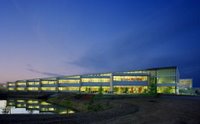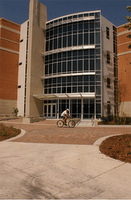LEED Building Olympics: Platinum, Gold, Silver: Part 3
Previously, I took a look at the basic tenants of LEED certifications, and then a bit later I examined the building fundamentals a bit more in detail, seeing what builders and urban planners might work towards to help gain progress toward a platinum LEED certification.
This time around, I'd like to tour some of some buildings that have managed to attain a LEED certification to get an idea of what sorts of things the builders have done to implement LEED standards in their projects.
1. The Mattress Factory, and Cherry Parkes building, University of Washington, Tacoma.
LEED Certification: Silver
These 100-year old buildings showcase their LEED certification points in a number of ways:
 2. 8800 Page, Missouri
2. 8800 Page, Missouri
LEED Certification: Platinum
This amazing office building receieved the highest LEED Certification point score in the world: 60 points! The achievements by the building team were quite noteable, listing only a few here:

3. Engineering And Computational Sciences Building, Old Dominion University, Virginia
LEED Certification: Basic
This interesting, brand-new lab features a number of innovative LEED progressions, such as:
4. Yesler Community Center, Seattle, Washington
LEED Certification: Silver
This community building showcases a number of different LEED methods, showing that sustainability can be a normal part of the public sector as well as the private one:
Certainly, each of these facilities we've looked at today features an extensive number of LEED features in addition to those we've seen. Hopefully, as builders and residents alike see the monetary and sustainability advantages of building according to LEED standards, we will continue to see an increasing number of green buildings constructed over time, both from scratch and from "re-cycled" older buildings.
Categories: LEED, architecture
This time around, I'd like to tour some of some buildings that have managed to attain a LEED certification to get an idea of what sorts of things the builders have done to implement LEED standards in their projects.
1. The Mattress Factory, and Cherry Parkes building, University of Washington, Tacoma.
LEED Certification: Silver
These 100-year old buildings showcase their LEED certification points in a number of ways:
- Water reduction achieved through use of ultra-low flow plumbing
- Over 58% of building materials were recycled
- Use of wall plantings to mitigate heating/cooling costs
- High performance glazing utilized to optimize energy efficiency
 2. 8800 Page, Missouri
2. 8800 Page, MissouriLEED Certification: Platinum
This amazing office building receieved the highest LEED Certification point score in the world: 60 points! The achievements by the building team were quite noteable, listing only a few here:
- Innovative Wastewater Technologies: A rainwater catchment system was designed to eliminate the need to use potable water for sewage conveyance. This system incorporates a cistern that captures rainwater from the garage roof; stores, filters and then uses it for sewage conveyance.
- Energy Recovery: An energy recovery system incorporated into the HVAC system extracts heat from the air without the need to re-circulate stale air. The building has operable windows: motor-controlled in the clerestory; manually operated on the first and second floors.
- Daylighting and Views: Research indicates visual exposure to the outdoors produces significant, quick recovery from stress. Virtually 100% of our employees have a direct view to the outdoors while seated at their workstation.

3. Engineering And Computational Sciences Building, Old Dominion University, Virginia
LEED Certification: Basic
This interesting, brand-new lab features a number of innovative LEED progressions, such as:
- No parking lots are being paved for the new building. The building integrates bicycle storage areas and alternative fuel recharging stations for futuristic vehicles.
- Native, drought-resistant plants and efficient drip irrigation will reduce the amount of water needed for landscaping. Efficient plumbing systems are expected to cut water use inside the building by 20 percent.
- Increased insulation, external sun-shading, windows that increase day-lighting and other innovations that increase the efficiency of mechanical systems should cut the building's energy demands by 20 percent.
4. Yesler Community Center, Seattle, Washington
LEED Certification: Silver
This community building showcases a number of different LEED methods, showing that sustainability can be a normal part of the public sector as well as the private one:
- 30% reduction in overall water use than a conventional building (achieved
through water efficient landscaping and efficient fixtures)
- Extensive shading on the south side to reduce summer solar gain
- Carbon Dioxide Monitoring
- Increased effectiveness of ventilation (operable windows that have been sized and
located using computer modeling)
Certainly, each of these facilities we've looked at today features an extensive number of LEED features in addition to those we've seen. Hopefully, as builders and residents alike see the monetary and sustainability advantages of building according to LEED standards, we will continue to see an increasing number of green buildings constructed over time, both from scratch and from "re-cycled" older buildings.
Categories: LEED, architecture

0 Comments:
Post a Comment
<< Home